Geology 307: Igneous and Metamorphic Petrology (Spring 2015)
Item set
- Title
- Geology 307: Igneous and Metamorphic Petrology (Spring 2015)
- Creator
- Tamara Carley
- Date Created
- 22 January 2015
Items
-
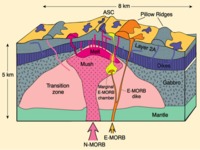 The tectonic settings for MORBs, OIBs and Convergent Margins are all very different. Magma that creates MORBs comes from the upper mantle. Since the upper mantle underneath a divergent boundary is responsible for producing so much magma, it is depleted in incompatible elements. OIBs on the other hand, are created by mantle plumes that are sourced from the core-mantle boundary. Since the plumes originate from the core-mantle boundary, they are rich in incompatibles. Island arcs from convergent margins originate from subduction zones. As the slab subducts, water from hydrated minerals escapes from hydrous mineral structures. The water then enters the surrounding mantle and lowers the melting temperature. Melt is then created and rises to the crust. Image 1 from: Winter, J. D. (n.d.). Igneous and Metamorphic Petrology Class Material. Retrieved May 6, 2015, from https://www.whitman.edu/geology/winter/ JDW_PetClass.htm Image 2 from: Young, J. Cape Verde’s Eruption: An Example of Hotspot Volcanism. 1 Dec 2014. http://www.decodedscience.com/cape-verdes-eruption-example-hotspot-volcanism/51069 Image 3 from: Winter, J. D. (n.d.). Igneous and Metamorphic Petrology Class Material. Retrieved May 6, 2015, from https://www.whitman.edu/geology/winter/ JDW_PetClass.htm
The tectonic settings for MORBs, OIBs and Convergent Margins are all very different. Magma that creates MORBs comes from the upper mantle. Since the upper mantle underneath a divergent boundary is responsible for producing so much magma, it is depleted in incompatible elements. OIBs on the other hand, are created by mantle plumes that are sourced from the core-mantle boundary. Since the plumes originate from the core-mantle boundary, they are rich in incompatibles. Island arcs from convergent margins originate from subduction zones. As the slab subducts, water from hydrated minerals escapes from hydrous mineral structures. The water then enters the surrounding mantle and lowers the melting temperature. Melt is then created and rises to the crust. Image 1 from: Winter, J. D. (n.d.). Igneous and Metamorphic Petrology Class Material. Retrieved May 6, 2015, from https://www.whitman.edu/geology/winter/ JDW_PetClass.htm Image 2 from: Young, J. Cape Verde’s Eruption: An Example of Hotspot Volcanism. 1 Dec 2014. http://www.decodedscience.com/cape-verdes-eruption-example-hotspot-volcanism/51069 Image 3 from: Winter, J. D. (n.d.). Igneous and Metamorphic Petrology Class Material. Retrieved May 6, 2015, from https://www.whitman.edu/geology/winter/ JDW_PetClass.htm -
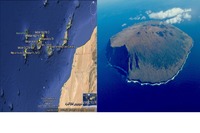 A comparative look at the landforms, magma settings, and the geochemistry of two ocean island chains.
A comparative look at the landforms, magma settings, and the geochemistry of two ocean island chains. -
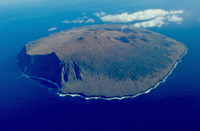 OIB—Amsterdam & St. Paul Islands Tectonic Magmatic Setting -Hotspot plume magmatism interacting with ridge in Indian Ocean (Fig 1) -Deep mantle plume rising through mantle beneath ridge and being influenced by both. -Kerguelen Hotspot is on Antarctic plate (Fig 2) -Kerguelen plateau located symmetrically across Indian Ocean Ridge was contiguous before mid-ocean ridge rifting. Hotspot track due north of broken ridge indicates North to South Plate Motion. -The Antarctic plate moved southward to its present location and is estimated at moving 1 centimeter per year Landforms Island Arc landform -Kerguelen Islands—group of islands in southern indian ocean—exposed part of Kerguelen plateau. -Amsterdam and St. Paul islands separated by 100km and a transform fault (Fig 3) -Visible parts of plateau due to effusive volcanism - -lava flow rather than explosive eruption — layers of basalt flow emerged above sea level showing staircase landform due to erosion (Fig 4) -Tens of meters of basaltic flows stacked atop one another (form staircase shape of columnar basalt) Magma Generating Processes -Kerguelen Plateau formed from initial volcanism of the Kerguelen Mantle Plume -Amsterdam,/St. Paul Islands composition inherited from oceanic crust/sediments recycled in mantle -Composition reflects interaction between Amsterdam St. Paul plume, Indian Ocean MORB mantle , and continental crust debris. -During breakup of Gondwana there were continental rocks stripped off deposited. -Plume, upper mantle, and lower crust collectively mix in different proportions creating geochemical variability in the lava. -40-45% ASP plume, 25-55% Indian Divergent Margin, 0-6% continental crust remains -Rising mantle plume with extreme heat melts rock of continent as plates move overhead. -Form shield volcanoes that occasionally rise above sea level and form a continuous strand of volcanos (Fig 2) GeoChemistry Island tholeiites such as Amsterdam and St. Paul Islands have higher LIL element abundances than ridge axis. The more primitive (less LIL, depleted magma) implies deep mantle source. -Basalts found on St. Paul are mildly alkalic and highly fractionated - -enriched in incompatibles -Different from tholeiitic basalts found on Amsterdam island due to different amounts of ridge influence. -Shield Volcanos like Amsterdam island location on a transform fault range from olivine tholeiites to plagioclase basalts depending on amount of influence. But stay in tholeiitic range. -Lava samples showing low alumina levels (similar to tholeiites of Hawaii)—indicating alkaline volcanism whereas lavas with high alumina levels show early stage oceanic ridge basalts. -Rare earth element concentration indicative of magma from deep mantle plumes that are representative of true mantle compositions similar to chondrites. -Graphs representing incompatibles show upward trend due to their fertile nature from deep in the mantle near the core-mantle boundary.
OIB—Amsterdam & St. Paul Islands Tectonic Magmatic Setting -Hotspot plume magmatism interacting with ridge in Indian Ocean (Fig 1) -Deep mantle plume rising through mantle beneath ridge and being influenced by both. -Kerguelen Hotspot is on Antarctic plate (Fig 2) -Kerguelen plateau located symmetrically across Indian Ocean Ridge was contiguous before mid-ocean ridge rifting. Hotspot track due north of broken ridge indicates North to South Plate Motion. -The Antarctic plate moved southward to its present location and is estimated at moving 1 centimeter per year Landforms Island Arc landform -Kerguelen Islands—group of islands in southern indian ocean—exposed part of Kerguelen plateau. -Amsterdam and St. Paul islands separated by 100km and a transform fault (Fig 3) -Visible parts of plateau due to effusive volcanism - -lava flow rather than explosive eruption — layers of basalt flow emerged above sea level showing staircase landform due to erosion (Fig 4) -Tens of meters of basaltic flows stacked atop one another (form staircase shape of columnar basalt) Magma Generating Processes -Kerguelen Plateau formed from initial volcanism of the Kerguelen Mantle Plume -Amsterdam,/St. Paul Islands composition inherited from oceanic crust/sediments recycled in mantle -Composition reflects interaction between Amsterdam St. Paul plume, Indian Ocean MORB mantle , and continental crust debris. -During breakup of Gondwana there were continental rocks stripped off deposited. -Plume, upper mantle, and lower crust collectively mix in different proportions creating geochemical variability in the lava. -40-45% ASP plume, 25-55% Indian Divergent Margin, 0-6% continental crust remains -Rising mantle plume with extreme heat melts rock of continent as plates move overhead. -Form shield volcanoes that occasionally rise above sea level and form a continuous strand of volcanos (Fig 2) GeoChemistry Island tholeiites such as Amsterdam and St. Paul Islands have higher LIL element abundances than ridge axis. The more primitive (less LIL, depleted magma) implies deep mantle source. -Basalts found on St. Paul are mildly alkalic and highly fractionated - -enriched in incompatibles -Different from tholeiitic basalts found on Amsterdam island due to different amounts of ridge influence. -Shield Volcanos like Amsterdam island location on a transform fault range from olivine tholeiites to plagioclase basalts depending on amount of influence. But stay in tholeiitic range. -Lava samples showing low alumina levels (similar to tholeiites of Hawaii)—indicating alkaline volcanism whereas lavas with high alumina levels show early stage oceanic ridge basalts. -Rare earth element concentration indicative of magma from deep mantle plumes that are representative of true mantle compositions similar to chondrites. -Graphs representing incompatibles show upward trend due to their fertile nature from deep in the mantle near the core-mantle boundary. -
MORBs form at divergent boundaries. These boundaries can be fast-spreading (half rate: 3 cm/year). Details on the effects of spreading rate on MORB composition as well as landforms can be found in the Geochemistry and landforms sections.
-
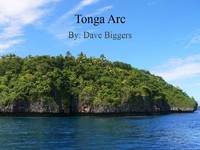
-
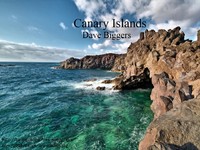
-
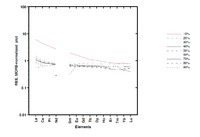 Geochemical analysis of global MORB data
Geochemical analysis of global MORB data -
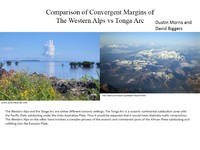 A description and Comparison of Convergent Settings, Western Alps and Tonga Arc.
A description and Comparison of Convergent Settings, Western Alps and Tonga Arc. -
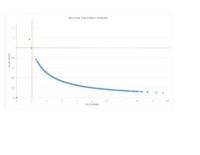 Geochemical Plots for the Cascade Volcanic Arc
Geochemical Plots for the Cascade Volcanic Arc -
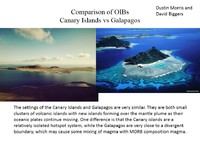 A description and comparison of the OIB settings of Canary Islands and Galapagos
A description and comparison of the OIB settings of Canary Islands and Galapagos -
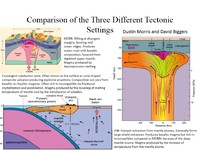 A description and comparison of the MORB, OIB, Subduction zone tectonic settings.
A description and comparison of the MORB, OIB, Subduction zone tectonic settings. -
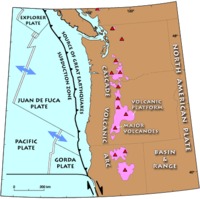 The Cascade Arc formed as a result of the subduction of the Juan de Fuca Plate System Beneath the North American Plate. This system is made up of the Juan de Fuca microplate as well as the smaller Gorda and Explorer plates. All three of these plates are remnants of the ancient Farallon Plate. The Cascades began to form 36 million years ago, however, the volcanoes that we see today have only begun to form over the past 1-2 million years.
The Cascade Arc formed as a result of the subduction of the Juan de Fuca Plate System Beneath the North American Plate. This system is made up of the Juan de Fuca microplate as well as the smaller Gorda and Explorer plates. All three of these plates are remnants of the ancient Farallon Plate. The Cascades began to form 36 million years ago, however, the volcanoes that we see today have only begun to form over the past 1-2 million years. -
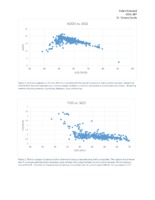 Convergent margins are the type locality for calc-alkaline melts, but are also the magmatic setting for nearly any other magma compositional series. The melt is sourced by the mantle wedge and evolves differently depending on how developed the overlying arc is. A mature arc will provide more evolved surrounding rock to assimilate into rising melts. This can alter the composition of melts to variable degrees depending on how high a thermal budget a rising melt has. Melts at arcs are also susceptible to the room problem. The result is stalling and potentially fractionation or other diversification processes. The geochemical trends discernible in major and trace element diagrams when compared to increasing silica content can inform upon the compositional character of the rocks produced by melts at the locality in question. The Aleutian Arc data set from GeoRoc encompasses a large set of samples and their whole rock geochemistry. Samples from along the entirety of the arc were used to best depict the overall character of the setting. The data reveals that the melts produced at the Aleutian Arc are generally calc-alkaline in nature. This statement is supported by the trends in the geochemical plots and their significance which is discussed in the caption of each plot.
Convergent margins are the type locality for calc-alkaline melts, but are also the magmatic setting for nearly any other magma compositional series. The melt is sourced by the mantle wedge and evolves differently depending on how developed the overlying arc is. A mature arc will provide more evolved surrounding rock to assimilate into rising melts. This can alter the composition of melts to variable degrees depending on how high a thermal budget a rising melt has. Melts at arcs are also susceptible to the room problem. The result is stalling and potentially fractionation or other diversification processes. The geochemical trends discernible in major and trace element diagrams when compared to increasing silica content can inform upon the compositional character of the rocks produced by melts at the locality in question. The Aleutian Arc data set from GeoRoc encompasses a large set of samples and their whole rock geochemistry. Samples from along the entirety of the arc were used to best depict the overall character of the setting. The data reveals that the melts produced at the Aleutian Arc are generally calc-alkaline in nature. This statement is supported by the trends in the geochemical plots and their significance which is discussed in the caption of each plot. -
 Sample taken from contact metamorphic layer, close to top. Grain size ranges from very fine to coarse. Hand sample and thin section shown. Plagioclase, potassium feldspar, quartz, and zircon are visible in thin section
Sample taken from contact metamorphic layer, close to top. Grain size ranges from very fine to coarse. Hand sample and thin section shown. Plagioclase, potassium feldspar, quartz, and zircon are visible in thin section -
 The Cascade Arc is home to many famous volcanoes! Here are a few volcanoes and other features of note.
The Cascade Arc is home to many famous volcanoes! Here are a few volcanoes and other features of note. -
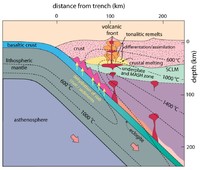 Magma generation at a convergent margin is a complex process. As the oceanic plate subducts beneath the Pacific Plate, the slab dewaters, lowering the melting temperature of the mantle between the Benioff Zone and the overriding plate. Here, a melt begins to form. As continental crust is light and buoyant, this melt has trouble rising. Therefore, very few primitive magmas will erupt at the surface at these settings. As the magma rises, several important processes occur. First, fractional crystallization and differentiation occur as the melt slowly cools underground. Assimilation occurs as the hot melt heats the surrounding country rock. Other processes, such as stoping, likely also occur. Some of the magma is unable to reach the surface and is trapped beneath the crust. Here, it cools and adds to the continental plate; a phenomena known as crustal underplating.
Magma generation at a convergent margin is a complex process. As the oceanic plate subducts beneath the Pacific Plate, the slab dewaters, lowering the melting temperature of the mantle between the Benioff Zone and the overriding plate. Here, a melt begins to form. As continental crust is light and buoyant, this melt has trouble rising. Therefore, very few primitive magmas will erupt at the surface at these settings. As the magma rises, several important processes occur. First, fractional crystallization and differentiation occur as the melt slowly cools underground. Assimilation occurs as the hot melt heats the surrounding country rock. Other processes, such as stoping, likely also occur. Some of the magma is unable to reach the surface and is trapped beneath the crust. Here, it cools and adds to the continental plate; a phenomena known as crustal underplating. -
 A convergent margin is formed when two lithospheric plates collide. The Aleutian Arc formed as the result of the Pacific plate colliding with the North American plate. The Pacific plate is subducting under the North American plate because it is denser (Fig. 1). The subducting plate is essential for even creating melts at the margin. The Pacific plate is moving NW at a rate of between 7 and 11 centimeters per year, whereas the North American plate is moving SW at only 1 centimeter a year. Magma is generated between the subducting slab and the overriding one in the mantle wedge. From there melt rises through the overriding plate creating an island arc chain such as the Aleutian Arc. As the magma rises it may assimilate surrounding rock, stall depending on how mature the overlying arc is physiographically, and evolve through the process of fractionation.
A convergent margin is formed when two lithospheric plates collide. The Aleutian Arc formed as the result of the Pacific plate colliding with the North American plate. The Pacific plate is subducting under the North American plate because it is denser (Fig. 1). The subducting plate is essential for even creating melts at the margin. The Pacific plate is moving NW at a rate of between 7 and 11 centimeters per year, whereas the North American plate is moving SW at only 1 centimeter a year. Magma is generated between the subducting slab and the overriding one in the mantle wedge. From there melt rises through the overriding plate creating an island arc chain such as the Aleutian Arc. As the magma rises it may assimilate surrounding rock, stall depending on how mature the overlying arc is physiographically, and evolve through the process of fractionation. -
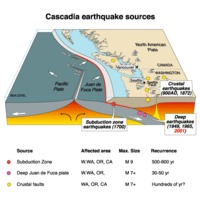 Convergent Margin: Cascades Tectonic Magmatic Setting -Volcanic arc formed due to subduction along Cascade (O-C convergence) subduction zone -Subduction of Juan de Fuca and Gorda plate beneath North American Plate (CM Figure 1) -plate moves 0.4 inches per year -large fault area (over 680 miles) produces violent earthquakes (CM Figure 3) Landforms -no oceanic trench - terrain and accretionary wedge uplift (plus heavy river sedimentation) -Cascade volcanic arc consists of stratovolcanos, shield volcanoes, lava domes, and cinder cones—over 20 major volcanoes (CM Figure 2) -Cascade Range collection of volcanic island arcs, deep ocean sediments, basaltic ocean floor, and parts of old continents that were carried into the North American plate by tectonic movement. Once these materials met North America they were shoved atop the plate and erosion began once above sea level. Volcanic eruptions also covered older rock with lava and ash. Magma Generating Process -Linear volcanic arc forms when subducting Juan de Fuca plate is dewatered and the volatiles released into overriding North American plate lower melting temperature, allowing formation of magmas and volcanic arc along linear subduction zone (CM Figure 4) -Volcanic rocks consist primarily of tholeiitic and high-alumina basalt and basaltic magmas erupt from shield volcanos and cinder cone after magma travels through continental crust (CM Figure 5) -some hornblende, pyroxene andesite, and dacites indicate existence of silica rocks from stratovolcanos Geochemistry -Geochemical graphs and Harker diagrams of various major elements vs. silica content are characteristic of subduction zone magma generation. -The increasing trend of incompatibles such as alkalis and decreasing trend of compatibles such as MgO and FeO occurs from melting of upper mantle and crust when subducting plate is dewatered. -Incompatible alkalis increase due to assimilation and other melting processes that incorporate constituents of surrounding rocks. Incompatibles are released from source rock first and continental crust such as North America is rich in incompatibles from previous magma generation. -Compatibles weight percentage will steadily decrease as the the influx of incompatible elements during melting changes the overall proportion of composition in the magma.
Convergent Margin: Cascades Tectonic Magmatic Setting -Volcanic arc formed due to subduction along Cascade (O-C convergence) subduction zone -Subduction of Juan de Fuca and Gorda plate beneath North American Plate (CM Figure 1) -plate moves 0.4 inches per year -large fault area (over 680 miles) produces violent earthquakes (CM Figure 3) Landforms -no oceanic trench - terrain and accretionary wedge uplift (plus heavy river sedimentation) -Cascade volcanic arc consists of stratovolcanos, shield volcanoes, lava domes, and cinder cones—over 20 major volcanoes (CM Figure 2) -Cascade Range collection of volcanic island arcs, deep ocean sediments, basaltic ocean floor, and parts of old continents that were carried into the North American plate by tectonic movement. Once these materials met North America they were shoved atop the plate and erosion began once above sea level. Volcanic eruptions also covered older rock with lava and ash. Magma Generating Process -Linear volcanic arc forms when subducting Juan de Fuca plate is dewatered and the volatiles released into overriding North American plate lower melting temperature, allowing formation of magmas and volcanic arc along linear subduction zone (CM Figure 4) -Volcanic rocks consist primarily of tholeiitic and high-alumina basalt and basaltic magmas erupt from shield volcanos and cinder cone after magma travels through continental crust (CM Figure 5) -some hornblende, pyroxene andesite, and dacites indicate existence of silica rocks from stratovolcanos Geochemistry -Geochemical graphs and Harker diagrams of various major elements vs. silica content are characteristic of subduction zone magma generation. -The increasing trend of incompatibles such as alkalis and decreasing trend of compatibles such as MgO and FeO occurs from melting of upper mantle and crust when subducting plate is dewatered. -Incompatible alkalis increase due to assimilation and other melting processes that incorporate constituents of surrounding rocks. Incompatibles are released from source rock first and continental crust such as North America is rich in incompatibles from previous magma generation. -Compatibles weight percentage will steadily decrease as the the influx of incompatible elements during melting changes the overall proportion of composition in the magma. -
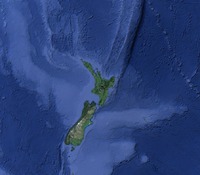 Tectonic Magmatic Setting: New Zealand is formed from the convergence of two oceanic plates, the Pacific, and the Indo-Australian Plate. The Pacific Plate is subducting underneath the Indo-Australian Plate at an approximate rate of 8cm/annum. Physiography/ Landforms: The convergent margin of two oceanic plates causes the formation of an ocean island arc on the overriding plate and a trench in the foreland of the arc. New Zealand is comprised of two islands, the North and South Islands. These islands are formed from multiple composite volcanoes which have all breached sea level and connected together. Just to the east of New Zealand is the Tonga Trench, a depression where the Pacific Plate is being pulled down in subduction. (Figure 1.)Magma Generation: The main driver for melt generation at subduction margins is the introduction of volatiles to the mantle source. At approximately 150 km in depth, the volatiles trapped in amphiboles and sediments carried by the subducting slab are extracted from the metamorphosis of the minerals in the slab. (Figure 2.) The volatiles will enter the mantle material, and change the solidus to be a wet solidus rather than a dry solidus. The wet solidus will shift to intersect the normal oceanic geotherm and allow melting to begin. This melt material will rise through the crustal material and undergo and evolution as time progresses. (Figure 3.)Geochemical Data Analysis and Interpretation: The Harker diagrams show that MgO concentration drops quickly with higher silica melts, along with FeO, CaO, TiO2, and P2O5. Al2O3 concentrations increase with low silica concentrations, but decrease at higher silica concentrations, along with NaO2, which starts decreasing at much higher silica concentrations. K2O is continually rising through all silica levels. There are many compatible elements for this system. The most compatible being MgO. FeO, CaO are readily found and compatible, while TiO2 and P2O5 have low concentrations, but are compatible in the system. Al2O3 is incompatible early in the system, but as the melt evolves to higher silica, feldspars can become more readily formed, making Al2O3 a compatible element in the system. Na2O mimics the Al2O3, only much later in the evolution when Alkali feldspars are able to stabilize. K2O is the only element which is not compatible at any point during the system. (Figure 4.)The Alumina Saturation diagram shows that the majority of the samples are peraluminous. This heavy concentration of aluminum implies that there is an aluminus source which has been depleted in the Alkali content due to the evolution of the melt over time. (Figure 5.)The Alkali vs. Silica diagram shows a strong trend Sub-Alkaline melts. This means that the source of the rock is a depleted source in incompatible elements, and has evolved over time. (Figure 6.)The FeO*/MgO vs. Silica graph shows a predominately calc-alkaline composition, but many samples are on the Tholeiitic side of the border. Calc-alkaline melts are the tendency for a more evolved melt setting characteristic of ocean arc settings, such as New Zealand, but the tendency towards Tholeiitic source implies that the melt is undergoing much less alteration as it progresses through the oceanic crust than other arc settings. (Figure 7.)The AFM Ternary diagram shows a heavily evolved calc-alkaline melt rich in Alkali components compared to the MgO and FeO components. This implies that the melt has undergone evolution and will produce a very diverse melt. (Figure 8.) The REE Chondrite-normalized Spider Diagram shows a heavy concentration in the less compatible REE. This implies that there is a low melt fraction from the source of the melt. The incompatible elements will leave the solid state first, causing a saturation of the elements in the melt which will rise and reach the surface. (Figure 9.)
Tectonic Magmatic Setting: New Zealand is formed from the convergence of two oceanic plates, the Pacific, and the Indo-Australian Plate. The Pacific Plate is subducting underneath the Indo-Australian Plate at an approximate rate of 8cm/annum. Physiography/ Landforms: The convergent margin of two oceanic plates causes the formation of an ocean island arc on the overriding plate and a trench in the foreland of the arc. New Zealand is comprised of two islands, the North and South Islands. These islands are formed from multiple composite volcanoes which have all breached sea level and connected together. Just to the east of New Zealand is the Tonga Trench, a depression where the Pacific Plate is being pulled down in subduction. (Figure 1.)Magma Generation: The main driver for melt generation at subduction margins is the introduction of volatiles to the mantle source. At approximately 150 km in depth, the volatiles trapped in amphiboles and sediments carried by the subducting slab are extracted from the metamorphosis of the minerals in the slab. (Figure 2.) The volatiles will enter the mantle material, and change the solidus to be a wet solidus rather than a dry solidus. The wet solidus will shift to intersect the normal oceanic geotherm and allow melting to begin. This melt material will rise through the crustal material and undergo and evolution as time progresses. (Figure 3.)Geochemical Data Analysis and Interpretation: The Harker diagrams show that MgO concentration drops quickly with higher silica melts, along with FeO, CaO, TiO2, and P2O5. Al2O3 concentrations increase with low silica concentrations, but decrease at higher silica concentrations, along with NaO2, which starts decreasing at much higher silica concentrations. K2O is continually rising through all silica levels. There are many compatible elements for this system. The most compatible being MgO. FeO, CaO are readily found and compatible, while TiO2 and P2O5 have low concentrations, but are compatible in the system. Al2O3 is incompatible early in the system, but as the melt evolves to higher silica, feldspars can become more readily formed, making Al2O3 a compatible element in the system. Na2O mimics the Al2O3, only much later in the evolution when Alkali feldspars are able to stabilize. K2O is the only element which is not compatible at any point during the system. (Figure 4.)The Alumina Saturation diagram shows that the majority of the samples are peraluminous. This heavy concentration of aluminum implies that there is an aluminus source which has been depleted in the Alkali content due to the evolution of the melt over time. (Figure 5.)The Alkali vs. Silica diagram shows a strong trend Sub-Alkaline melts. This means that the source of the rock is a depleted source in incompatible elements, and has evolved over time. (Figure 6.)The FeO*/MgO vs. Silica graph shows a predominately calc-alkaline composition, but many samples are on the Tholeiitic side of the border. Calc-alkaline melts are the tendency for a more evolved melt setting characteristic of ocean arc settings, such as New Zealand, but the tendency towards Tholeiitic source implies that the melt is undergoing much less alteration as it progresses through the oceanic crust than other arc settings. (Figure 7.)The AFM Ternary diagram shows a heavily evolved calc-alkaline melt rich in Alkali components compared to the MgO and FeO components. This implies that the melt has undergone evolution and will produce a very diverse melt. (Figure 8.) The REE Chondrite-normalized Spider Diagram shows a heavy concentration in the less compatible REE. This implies that there is a low melt fraction from the source of the melt. The incompatible elements will leave the solid state first, causing a saturation of the elements in the melt which will rise and reach the surface. (Figure 9.) -
 Ocean islands generally occur on the interior of oceanic plates. Hot spots form from rising plumes and island chains can form as the plate moves over the hot spot. The Selvagen Islands are on the African plate off the coast of Morocco.
Ocean islands generally occur on the interior of oceanic plates. Hot spots form from rising plumes and island chains can form as the plate moves over the hot spot. The Selvagen Islands are on the African plate off the coast of Morocco. -
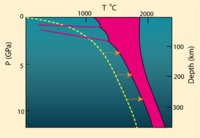 Magma is generated at Mid-Ocean Ridges through decompression melting. Decompression melthing happens because as the plates are pulled apart, and become thinner, the underlying mantle is subjected to less pressure. Because the pressure is reduced, conditions become such that the geothermal gradient allows for melting. The reduced pressure allows melting to occur in large quantities. Usually between 10 and 30 percent of the mantle material is melted, depending on the temperature of the mantle. Due to density differences, the magma then rises and is forced out through dikes. Picture from: Winter, J. D. (n.d.). Igneous and Metamorphic Petrology Class Material. Retrieved May 6, 2015, from https://www.whitman.edu/geology/winter/ JDW_PetClass.htm
Magma is generated at Mid-Ocean Ridges through decompression melting. Decompression melthing happens because as the plates are pulled apart, and become thinner, the underlying mantle is subjected to less pressure. Because the pressure is reduced, conditions become such that the geothermal gradient allows for melting. The reduced pressure allows melting to occur in large quantities. Usually between 10 and 30 percent of the mantle material is melted, depending on the temperature of the mantle. Due to density differences, the magma then rises and is forced out through dikes. Picture from: Winter, J. D. (n.d.). Igneous and Metamorphic Petrology Class Material. Retrieved May 6, 2015, from https://www.whitman.edu/geology/winter/ JDW_PetClass.htm -
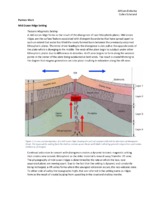 The investigation includes explanations, descriptions, and discussions of the tectonic magmatic setting, the landforms, magma generating processes, and geochemical characteristics of a typical mid ocean ridge.
The investigation includes explanations, descriptions, and discussions of the tectonic magmatic setting, the landforms, magma generating processes, and geochemical characteristics of a typical mid ocean ridge. -
 A description of the landforms, magmatic settings, and geochemistry of Mid Ocean Ridges
A description of the landforms, magmatic settings, and geochemistry of Mid Ocean Ridges -
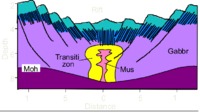 Mid-Ocean Ridges are responsible for producing many interesting landforms. Some of these landforms include the rift valley, down-drop blocks and sheeted dikes. The rift valley is the inner most part of the ridge where magma is extruded from the ridge. In the rift valley, there are down-drop blocks. Sheeted dikes are formed as dikes that bring the magma to the surface, however, as the two plates diverge, the dikes are pulled apart and a new dike forms in its place. Picture from: Winter, J. D. (n.d.). Igneous and Metamorphic Petrology Class Material. Retrieved May 6, 2015, from https://www.whitman.edu/geology/winter/ JDW_PetClass.htm
Mid-Ocean Ridges are responsible for producing many interesting landforms. Some of these landforms include the rift valley, down-drop blocks and sheeted dikes. The rift valley is the inner most part of the ridge where magma is extruded from the ridge. In the rift valley, there are down-drop blocks. Sheeted dikes are formed as dikes that bring the magma to the surface, however, as the two plates diverge, the dikes are pulled apart and a new dike forms in its place. Picture from: Winter, J. D. (n.d.). Igneous and Metamorphic Petrology Class Material. Retrieved May 6, 2015, from https://www.whitman.edu/geology/winter/ JDW_PetClass.htm -

